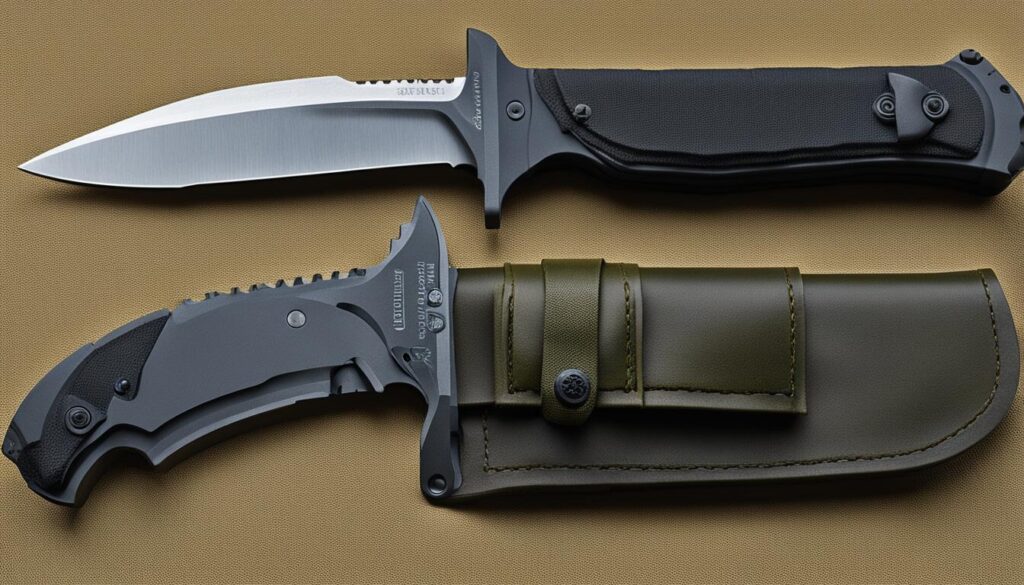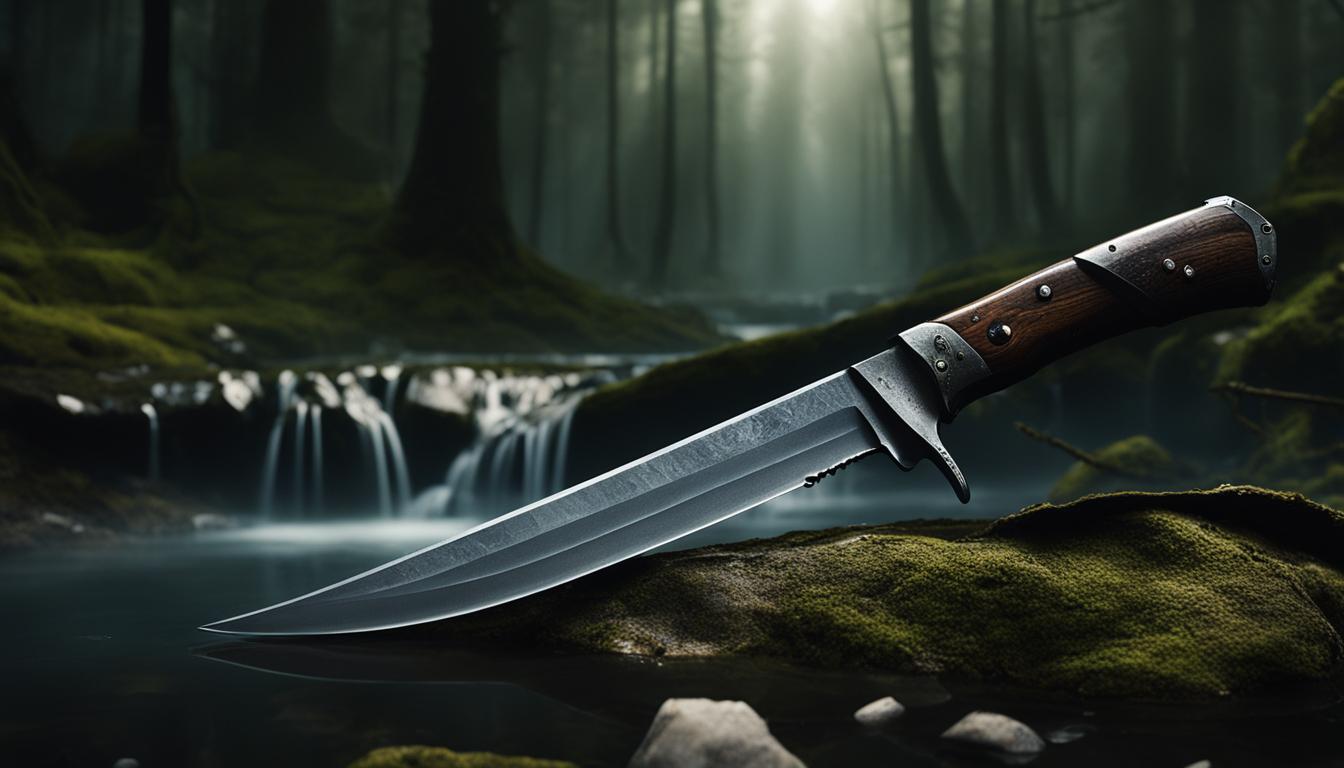When it comes to selecting a survival knife for hunting in a survival situation, blade length is a crucial factor to consider. A blade length of 4 to 6 inches is ideal for most survival situations. This size offers a good balance between control and versatility, allowing for tasks such as carving, chopping, and light batoning. While it may be tempting to choose a larger blade, it’s important to remember that bigger isn’t always better in survival situations.
Key Takeaways:
- Blade length of 4 to 6 inches is ideal for survival situations.
- A balanced blade length offers control and versatility.
- Carving, chopping, and light batoning can be done effectively with this size.
- Choosing a larger blade doesn’t necessarily mean better performance in survival situations.
The Role of Blade Shape in Survival Knives
When it comes to survival knives, the shape of the blade plays a vital role in determining its effectiveness in various tasks. Two of the most versatile blade shapes for survival knives are the drop point and clip point.
The drop point blade shape is characterized by a slightly convex curve on the spine, which leads to a sharp, strong tip. This shape provides excellent control and durability, making it ideal for heavy-duty tasks such as batoning and prying. Additionally, the wider belly of the drop point blade is perfect for slicing and skinning game.
On the other hand, the clip point blade shape features a more pronounced curve on the spine, leading to a sharper and more precise tip. This shape is ideal for tasks that require precision, such as carving or intricate cutting. The clip point design also allows for better maneuverability, making it suitable for various outdoor activities.
Comparing Drop Point and Clip Point Blade Shapes
| Drop Point | Clip Point |
|---|---|
| Wide belly for slicing and skinning | Pronounced curve for precision cutting |
| Strong, durable tip for heavy-duty tasks | Sharp tip for intricate cutting |
| Ideal for general outdoor tasks | Suitable for precise tasks |
Ultimately, the choice between the drop point and clip point blade shapes depends on the specific requirements of your survival situation. If you anticipate needing to perform heavy-duty tasks or require a more robust and versatile blade, the drop point shape may be the better option. However, if precision and maneuverability are key factors, the clip point shape may be more suitable for your needs. Regardless of the blade shape you choose, it’s important to select a high-quality survival knife that is built to withstand the demands of survival situations.
Choosing the Right Blade Material for Survival Knives
When it comes to selecting a survival knife, one crucial aspect to consider is the blade material. The choice of blade material will greatly impact the knife’s strength, durability, and overall performance in a survival situation. Two common options for blade materials are high carbon steel and stainless steel, each with its own unique properties.
High carbon steel is known for its exceptional strength and ability to maintain a sharp edge. This type of blade material is highly regarded for its durability and is often preferred by experienced survivalists. With its superior hardness, high carbon steel can withstand heavy use and abuse without losing its edge.
On the other hand, stainless steel blades offer excellent resistance to corrosion, making them ideal for survival situations in wet or humid environments. Stainless steel is highly durable and requires minimal maintenance, as it is less prone to rust and staining. This blade material is a popular choice among those who prioritize ease of maintenance and longevity.
When deciding between high carbon steel and stainless steel, it ultimately boils down to personal preference and the specific demands of your survival situation. Consider factors such as the expected environment, the type of tasks you anticipate performing with the knife, and your own experience level. Both high carbon steel and stainless steel are reliable options, so choose the blade material that aligns best with your needs.
Comparing High Carbon Steel and Stainless Steel
| Blade Material | Strength | Durability | Corrosion Resistance |
|---|---|---|---|
| High Carbon Steel | High | High | Low |
| Stainless Steel | Medium | High | High |
In summary, choosing the right blade material is essential for ensuring the reliability and performance of a survival knife. High carbon steel offers exceptional strength and edge retention, while stainless steel provides excellent corrosion resistance and ease of maintenance. Consider your specific needs and preferences when selecting the blade material, and remember that both options have their own advantages in different survival situations.
Features to Consider for the Handle and Sheath of a Survival Knife
When choosing a survival knife, it’s important to carefully consider the features of the handle and sheath. These components play a crucial role in the usability, safety, and overall effectiveness of the knife in survival situations. Here are some key factors to keep in mind:
Survival Knife Handle
The handle of a survival knife should provide a comfortable grip, even when wet, to ensure secure handling in various conditions. There are several handle materials commonly used in survival knives, each with its own advantages and disadvantages:
- Rubber: Rubber handles offer excellent grip and are resistant to slipping, making them a popular choice for survival knives.
- Textured G10: G10 is a high-pressure fiberglass laminate that provides exceptional grip, durability, and resistance to moisture.
- Wood: Wooden handles offer a traditional look and feel, but they may require more maintenance and can be less durable than other materials.
- Paracord: Some survival knives feature handles wrapped in paracord, which can be unraveled and used in emergency situations.
Sheath for Survival Knives
A quality sheath is essential for safely carrying and storing a survival knife. It should securely hold the knife in place and allow for easy and quick access when needed. Here are a few popular sheath materials:
- Kydex: Kydex is a durable, lightweight, and waterproof material that is commonly used in high-quality sheaths. It offers excellent retention and protection for the knife.
- Nylon: Nylon sheaths are lightweight, affordable, and resistant to water. They often feature additional pockets or straps for carrying other survival tools.
- Leather: Leather sheaths are known for their durability and classic appearance. They require more maintenance to prevent moisture damage.
When selecting a sheath, consider the attachment options available, such as belt loops or MOLLE compatibility, to ensure convenient and secure carrying.

Overall, the handle and sheath of a survival knife should be chosen with careful consideration to ensure optimal performance and safety in survival situations. The handle should provide a comfortable and secure grip, while the sheath should securely hold the knife and allow for easy access. By paying attention to these features, you can select a reliable and trustworthy survival knife that will serve you well in challenging environments.
Conclusion
In determining the optimal blade length for a survival knife, it is essential to strike the right balance between control and versatility. From my research, a blade length of 4 to 6 inches emerges as the most suitable option for survival situations. This size allows for various tasks such as carving, chopping, and light batoning.
While some may be tempted to opt for a larger blade, it is crucial to remember that bigger does not always equate to better in survival scenarios. The 4 to 6-inch blade length offers sufficient maneuverability and control without compromising on functionality.
Additionally, it is vital to consider the shape, material, handle, and sheath of the survival knife. The drop point and clip point blade shapes are versatile, offering a strong, sharp tip and a curved edge for slicing. When it comes to blade material, deciding between high carbon steel and stainless steel depends on personal preference and the specific environment in which the knife will be used. A comfortable handle made of rubber or textured G10 improves grip even when wet, while a quality sheath made of durable materials like Kydex or nylon ensures secure storage and easy accessibility.
By carefully considering all these factors, you can select a survival knife that is perfectly suited to your needs. Remember, the right blade length, shape, material, handle, and sheath can make all the difference in enhancing your chances of survival in the wild.
FAQ
What is the ideal blade length for a survival knife?
A blade length of 4 to 6 inches is considered ideal for most survival situations.
Which blade shapes are the most versatile for survival knives?
The drop point and clip point blade shapes are the most versatile options for survival knives.
What are the most common materials used for survival knife blades?
High carbon steel and stainless steel are the most common materials used for survival knife blades.
What factors should I consider when choosing a handle for a survival knife?
Consider materials like rubber or textured G10 for a comfortable and secure grip.
What are some popular sheath materials for survival knives?
Kydex and nylon are popular sheath materials due to their durability and lightweight nature.
Source Links
- https://www.tektoknives.com/blogs/news/survival-essentials-the-significance-of-a-trustworthy-knife-and-firearm-in-harsh-conditions
- https://www.police1.com/police-products/duty-gear/knives/articles/6-things-you-should-know-before-buying-a-survival-knife-TNBggAWk1r7CosYT/
- https://www.linkedin.com/pulse/best-features-survival-knife-turqgear





